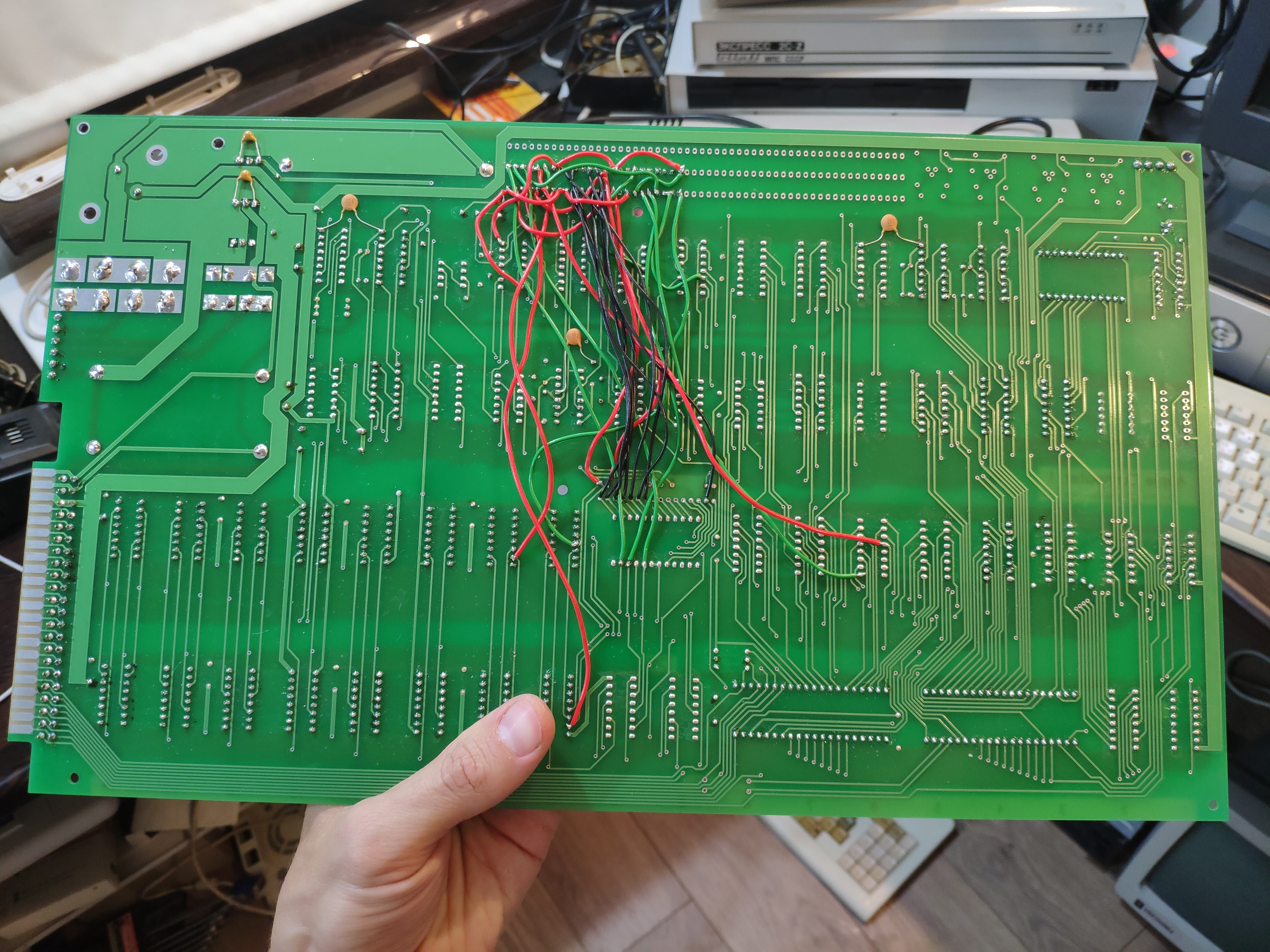Hi guys!
My youngest son Ivan is graduating from college this year. I proposed him a topic for his thesis project, "Assembling an Apple-1 personal computer from readily available components" and just today his faculty supervisor unexpectedly approved it. So we should have it all set up by early summer.
The project will consist of two parts, the first introductory part will be about the history of the creation of this wonderful computer, and the second is a presentation of the working computer and all the replacements made. I think that for a basis we will take a replica on the Soviet microchips, which a few years ago collected my friend Alexander, and add to it replacements of rare microchips Signetics 2513 and 2519 from P-Lab, EPROM card and maybe something else. Power supply - by direct feeding method from Mean Well RT-65B switching power supply. The motto of the project - the simpler the better! In general, it will be such a Frankenstein monster :) If you have any other ideas what else can be replaced I will be glad to hear it. Thanks in advance!




Here is a refence book that I have used extensively to help find Soviet equivalents. It's in Bulgarian, but the two languages are close enough to understand, especially in written form:
Short Integrated Circuits Reference Book
Thank you! 70-80% clear at once, I'll deal with the rest somehow.
Great! One more important point I omitted: the Soviet Union with its fabrication facilities in Russia and Ukraine was not the only producer of western equivalents. Many of the countries in Eastern Europe also produced their own chips. This reference book lists some of them starting on page 171:
CountryNames.png
The weird abbreviations are the formal "socialist republic" names:
СССР – USSR (Soviet Union)
ЧССР – Czechoslovak Socialist Republic (Czechoslovakia)
ГДР – German Democratic Republic (East Germany)
ССР – Socialist Republic Romania (Romania)
ПНР – Polish People’s Republic (Poland)
УНР – Hungarian People’s Republic (Hungary)
These equivalent chips are still widely available in their corresponding countries.
Thank you for your help!
We don't aim to build Apple-1 only on Soviet chips as in Alexander's project, our goal is to build a computer from more affordable components. Not necessarily Soviet.
The 2513 and 2519 second floor replacements are great for that.
Novichok adapter for PS/2 keyboard, a card for replacing PROM's with EPROM's, an external EPROM card also make it much easier to find the necessary parts.
8T97 > 74LS367, LM 323k > UA78H05ASC, MK4096 > MK4027 and the like...
In general it is a good opportunity to try to replace the maximum number of 74xx series chips with 74LSxx, but without global changes on the board. I think it would be a more versatile and interesting project than just building a replica on Soviet chips.
So far such thoughts, but it is still to be discussed with the supervisor of the graduation project.
Sounds like a great father and son project! Have fun and good luck.
In post #7, "oaddepe" wrote:
" Have you considered using a modern FPGA for any of the emulated components? It could be an interesting way . . . "
Uncle Bernie comments:
Oh, please don't do that to the Apple-1. While FPGAs are powerful and useful devices, they are not suited for educational projects like this one, where it is about (I suppose from reading the OP) showing how an Apple-1 could be assembled using "readily available" ICs from the Soviet Union era. IMHO, this demonstration would prove the interesting point that if back in Y1976 there had been a Steve Wozniak equivalent in the Soviet Union, and not a centrally planned economy where individual innovators were prohibited, then even the Soviet Union could have built a "People's Computer" like the Apple-1, with about the same performance.
When using vintage Eastern Bloc ICs from the era, it can be discussed on a gate to gate and flipflop to flipflop basis where the equivalence is.
With an FPGA this is not possible. Using FPGAs, everything is described in a HDL like Verilog or VHDL and then automatically synthesized and then fitted into the FPGA, and the outcome is almost impossible to understand, even if it works as expected. All you get from the automated process is a mess of CLBs interconnected in intractable ways. While this is great for rapid prototyping and testing of concepts before turning them into full custom ICs, it is not good for educational purposes in the electronics field - other than for the special purpose to teach Verilog or VHDL.
- Uncle Bernie
Another comment for those interested in FPGAs:
IMHO, FPGAs are somewhat of an odd duck product. Do these companies making them really make great profits ? Are they really commercially viable ? AFAIK, all of the semiconductor companies making FPGAs (such as XILINX, Altera, etc.) were bought by larger semiconductor corporations and then most of their FPGA products were discontinued. This does not look good to prospective investors. I always was wary of FPGAs and although we used them for prototyping and test of concepts, for many decades, where they are very useful and welcome, I always saw the issue with real products based on FPGAs: in most cases, too expensive and too slow compared to a full custom IC solution. And a bunch of professional prototypers, a few hobbyists, and some small businesses who can't afford full custom or semicustom IC development don't make a large market for those FPGAs. Just look around if can find FPGAs in mass produced consumer products. I never found even one example. FPGAs look more like a niche market product with no large numbers sold. Same thing as with super high performance / super high accuracy opamps, super precision voltage references, etc. How many of these technological marvels can their manufacturer sell per year ? 50 ? 100 ? 1000 ? Even if they charge $100 per such IC, there is no money to be made with this kind of niche products. FPGAs may suffer from the same issue, even if they sell in larger numbers (they do). So the economical viability must be questioned. I never was able to investigate the cash flow of these FPGA companies and never invested a dime of my money into any of them. -UB
"oaddepe" is just a link-inserting bot that uses an LLM, not a real person.
That was the problem with the Soviet Union, there was no incentive for individual development. You could work as a director of a large factory and earn 180 rubles a month, or as a loader and earn 120 rubles. Of course, you could always steal and sell something, but there was nothing to spend the money on. There was no private property. The only thing that could motivate was ideology. But as soon as Gorbachev removed the article on the primacy of the Communist Party from the Constitution, everything began to crumble.
"The government pretends to pay us, and we pretend to work" is an anecdote from the USSR.
is completely off-topic for this thread (and was inserted by a robot, not a human correpondent). In the near future, distinguishing between AI slop and actual ideas is going to be a critical skill. It will be very challenging when some sectors, like academia, are already awash with barely-intelligible verbiage. When will an AI-generated "Sokal hoax" be revealed?
But to complete the circle, I have found FPGAs in quite a few products; I think the oldest were so-called Photoshop accelerators from the early 1990s. Were those "mass produced consumer goods"? I think what really happened is that they largely displaced mask gate arrays of the kind made by LSI Logic and VLSI Technology (both of which are defunct).